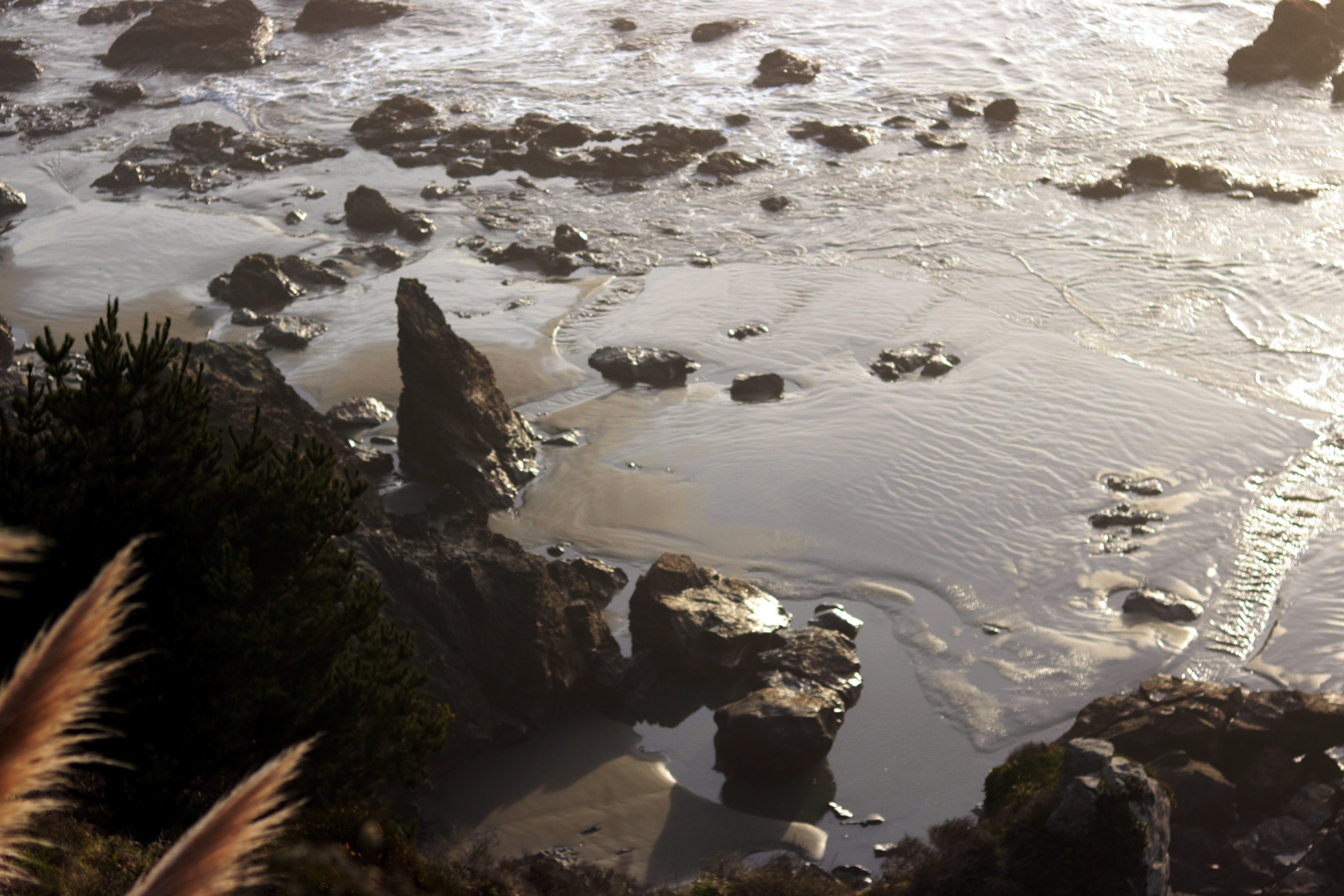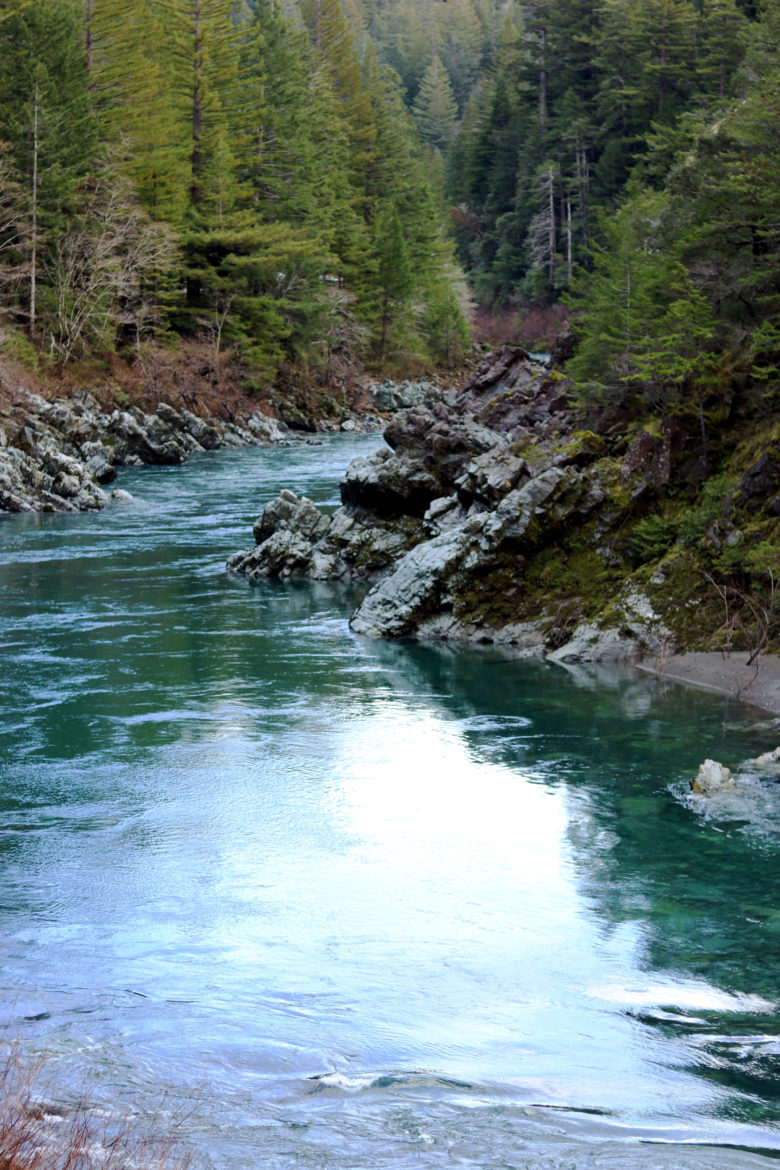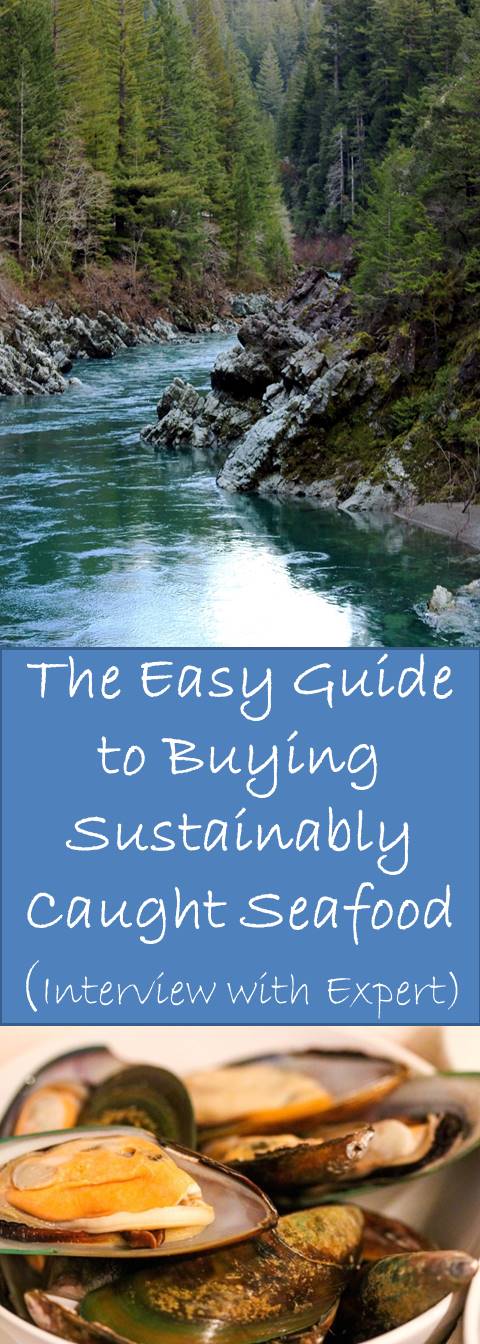I’m so excited to share this interview with you, all my readers! It is possibly the most useful thing yet on the blog giving you real tangible strategies for consuming fish ethically and sustainably. I was lucky enough to sit down with Lyf Gildersleeve, an active advocate for sustainable seafood and sustainable seafood business owner. He is funny, charismatic and incredibly knowledgeable, I could have picked his brain all day, but I was so humbled to have him take a little time out of his hectic schedule to talk to me about sustainable seafood in an effort to spread awareness.
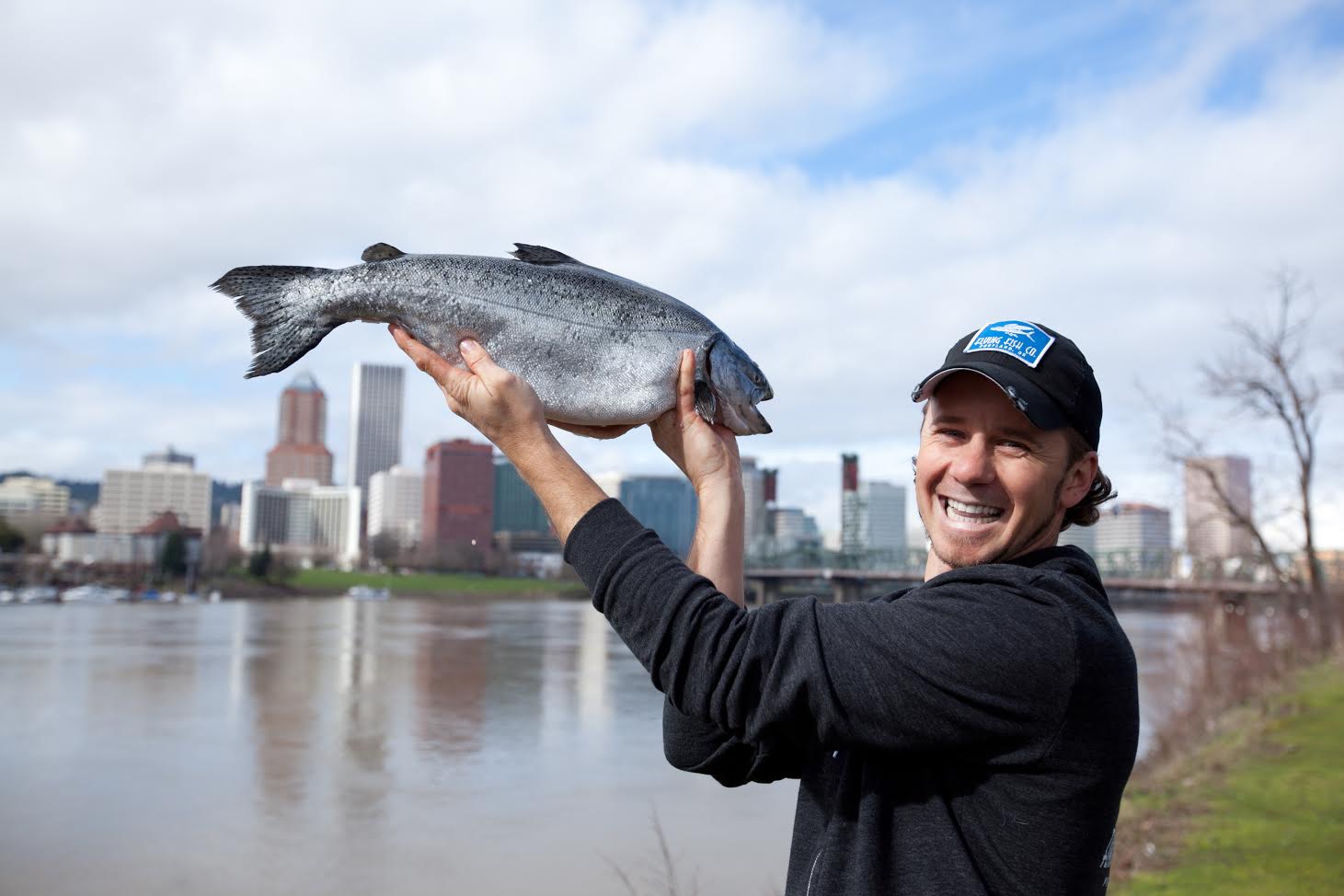
Quickly though before we delve into the interview I want to answer the question, “What does sustainable seafood mean?” Well first let’s answer, “What is food sustainability?” Sustainability literally means something that can be maintained. So food sustainability is food being produced in a fashion that is not depleting the Earths resources, because if we deplete the Earth of its resources there will be no food to eat. Food is a resource/ takes resources to produce. So what does this mean specifically for fish? Right now over-fishing, pollution, and global warming are causing havoc in the oceans. Ecosystems are changing in ways they never have before and this means the endangerment and extinction of a lot of marine species. Our current practices are unsustainable if we want to keep eating seafood and have oceans full of marine diversity. If not for the compassion of hundreds of thousands of marine species our oceans play an important role in human society too. Seafood is important to many cultures and is an excellent source of many fat soluble vitamins, minerals and omega- 3 fatty acids. AKA the good stuff.
I find it interesting that people talk about sustainability like it is a nice choice to make. Sustainability is not a choice, it is a necessity, because the very definition of unsustainable means you can’t do it forever. And right now our oceans are in grave danger. Today we are going to learn how to find sustainably sourced seafood, so that we can protect our oceans for generations of marine and human life to come. Remember, when you buy from an unsustainable or unethical business you are giving them a thumbs up. If that is a new concept to you or you want to learn more about ethical consumerism I have a discussion of it’s importance here and tips for becoming a more ethical consumer here. Now for the interview!
In this Interview You Will Learn:
- About Flying Fish Co Sustainable Seafood
- What goes into regulating the waters to ensure seafood is sustainably sourced
- How to kill a fish ethically
- What to look for as an ethical consumer when trying to buy sustainable seafood
- What the most sustainable seafood choices are
- The good and the bad of fish farming and where we hope it’s heading
- The challenges specific to being a sustainable business owner vs. a regular grocery store
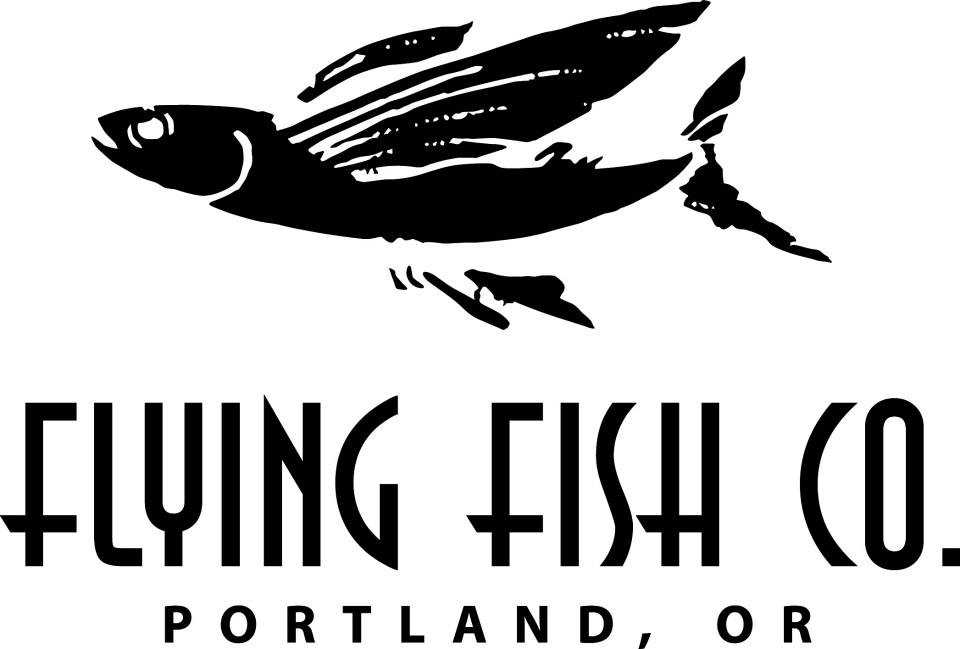
*Disclaimer: A little of this content is paraphrased for clarity purposes. However, most of the interview below is composed of direct quotes from Lyf Gildersleeve and myself.*
Sustainable Seafood Interview- All About Fish:
Kelsey: Can you tell me a little about yourself and Flying Fish Co?
Lyf: Yeah, so my name is Lyf Gildersleeve and my family started Flying Fish Company before I was born in my hometown Sandpoint, Idaho. And so in Northern Idaho- inland obviously- my dad used to fly small planes, cessnas, and instruct them. So he’d fly all the time over from Sandpoint to Seattle- it’s only about 350 miles- and pick up a box of fish and bring it back inland and sell it. So it was “flying fish”; that’s how it started. As a kid I grew up packaging fish and selling fish in the market in our little thing. It was just a little part time dealer, like Wednesdays and Fridays. So it’s been a family business forever.
Then I studied aquaculture in college down in Ocean Graphic Institute in Florida, called Harbor Branch Oceanographic Institute. [I] worked in different fields like that for a while, and then moved up to Utah… ski bummed up there for a while and got out of fishery [a place where fish are caught for human consumption] stuff until the recession hit and I lost my job and couldn’t find any other work. So I went back to my roots at that point and knew how to do fish, so I said, “Okay”. Got a little loan and started selling fish at the farmers’ markets in Utah and ended up getting married there. [I] had my daughter, and then we didn’t want to raise her in Utah so we moved to Oregon where my sister-in-law lives, here in Portland.
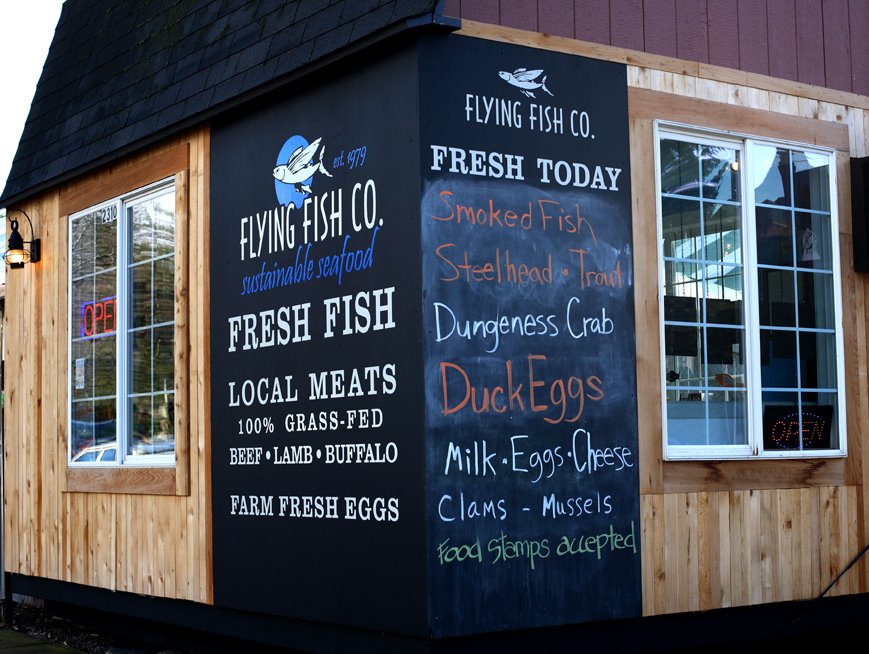
There was just an opportunity. There is not a lot of fish in this town and I wanted to focus more on just having a fish market, but the sustainable key was an important factor for me. So my slogan was, “Flying Fish Company: Sustainable Seafood”. When I came here I had a truck, like a step van- kind of like a food cart- that I started in over on Division. So I was in this food cart pod where everyone was selling lunch and dinner and stuff and I was selling my fresh fish. That lasted for six months or so, and then I started moving to another spot on Hawthorn and then I was back and forth. So for the first week of [doing both], was out of my truck and then the second spot was a produce tent that invited me over there, because I’m the protein and they’re the produce. That was five years ago now. And that really helped both of our businesses. We both doubled our business and revenues multiple times and it was great being paired up next to a grocer rather than next to food trucks.
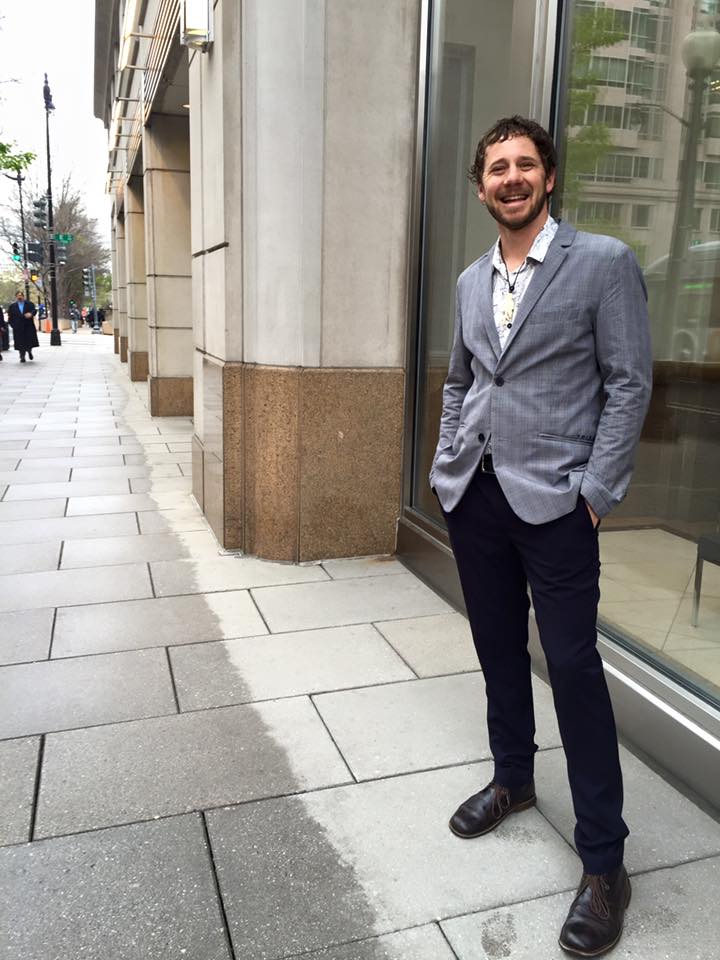
So really I source a lot of my fish from local fisherman and oyster farmers for the oyster bar. I’m an advocate for sustainable seafood in the sense that I’ll go testify at the Pacific Fisheries Management Council meetings where they make the regulations on how many fish can be caught and that sort of thing. Actually, this Spring I got flown out to Washington, D.C. to go talk to our Congressman and Senators about the fisheries policies and the Magnuson-Stevens Reauthorization. Our national fisheries policy needs to be reviewed in Congress and their are Republicans in there that are trying to pass this other Bill called the “Empty Oceans Act” [nickname] that’s loosening the belt on fisheries basically. So yeah, I do advocacy work outside of just owning a fish market. I’ve got a vested interest in fisheries, because that’s what I make my living off of. But I also want to make sure that it stays there. Coming from an aquaculture world as well, if I sell farmed raised fish I make sure it’s sustainably raised, and there is no artificial color and no growth hormones and antibiotics and that sort of thing.
Kelsey: It’s interesting that you were saying that you have a vested interest in there still being fish in the ocean so you can keep your job. I’d never thought about it that way.
Lyf: Well yeah, it can be looked at both ways. I’ve got a vested interest in that I want there to be fish harvested, but also for the long term sustainability of our oceans. But yeah, humans are f*****g a** w****s.
Kelsey: [Chuckles] Seriously. I feel like the more I learn about ethical consumerism, the less I know about ethical consumerism. It’s every avenue. It’s not just food; it’s everything we consume and we consume a lot. It’s a lot to think about every time we buy stuff, but basically at the end of the day we just have to consume less. You can’t impulse purchase when you actually dedicate yourself to doing the research on everything you are buying. It’s crazy how we just take and take and take, and it’s not a symbiotic relationship with anything. You know? I’m glad there are people who are starting to not seeing it that way, but as a whole it’s definitely how we treat the Earth and it’s inhabitants. It’s a bummer.
Lyf: Exactly, the cleaning chemicals that we use, and whatever. It relates to so many different things. Yeah, it’s so challenging. As a consumer and a business owner and all the above it’s a complex equation. But I think just general mindfulness every step of the way, in whatever hat that you are wearing is just important. Using that piece of paper or not, or using the back of a piece of paper you’re actually not going to use. Ya know? Just general mindfulness [is a good way to start changing our habits.] I like mindfulness; it’s a good word.
Kelsey: How do you find the fishermen that you get your sustainable seafood from? Do you interview them?
Lyf: Yeah sure. It’s definitely a relationship. Nowadays I get a lot of guys coming to me. So those spot prawns over there, that was a fisherman in Alaska that contacted me this week. A new contact for me; they’ll search for fish markets in Portland and I’ll come up. So nowadays I get people contacting me when they have products to sell. But originally I had to go out to the coast into the ports and try to find fisherman, and then be able to get it delivered too. I can’t go driving up and down the coast; I don’t have the capacity to be able to be sending people up the coast to be able to get it. And yeah, there is definitely a level of interviewing and making sure they are handling the product, because most fisherman are used to selling their product to a commodity distributor where it doesn’t matter if they handle the product well or not. It all just goes into the totes and out the door and they buy it all. There is nothing, even if the fish is half way split apart it just goes through. Whereas me, I am much more sensitive. I want those fish being taken care of on the boat, bled and iced properly, and handled properly so that the consumer gets the best quality product possible.
The local albacore tuna is a great example of that. My guys that fish the Colombia River; I go fishing with them. I get to go out and go fishing and get to actually physically handle the fish and do everything myself. That’s when you really get a handle of what’s going on. That’s kind of what I do.
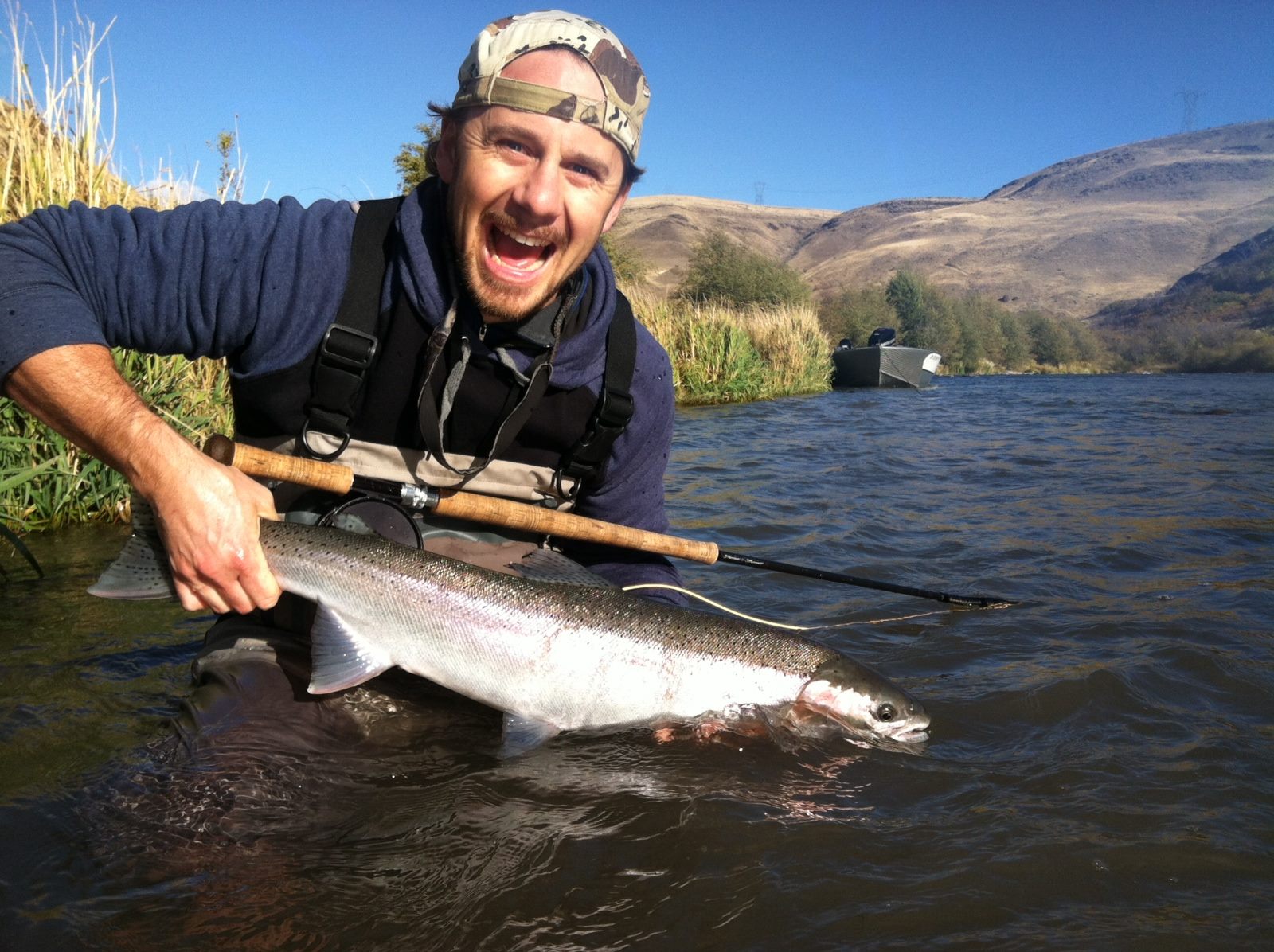
Kelsey: So what are your specific sustainable seafood standards to ensure proper care of fish?
Lyf: Bleeding the fish is definitely important for salmon and tuna in particular. You cut their gills so the blood goes out of their system and the fillet doesn’t have the little veins of blood in them. Those veins will deteriorate faster, because blood is really nutrient rich so bacteria can grow fast. So when you don’t have that blood in there a fish fillet is going to last a lot longer. Same with tuna if you are eating it raw and stuff; it will have a better flavor if you don’t have blood in the flesh. That’s part of it. And ya know, like I said already, handling it well on the boat. You don’t want them flopping on the deck and bruising themselves every time. And then how you ice them [is important]. The best way to do it is in slush ice, so water with ice mixed in. It brings the temperature down a lot faster, rather than just packing the tuna in [straight ice]. Tuna, for example, are 60 degrees because they are swimming all the time; they are an active species. If you just take them on board they flop around on the deck for a while and then you put them right into the hole, into the packed ice. It’s kind of like an igloo. You know how when you get in a snow igloo the moisture creates a pocket like an oven inside. So if you just pack that 60 degree fish in straight ice you are going to create an igloo, so the internal guts of the fish is going to stay warm for quite some time. That’s part of the element of handling them properly.
Kelsey: You kind of answered this already, but as far as humanely killing fish… there are a lot of different ways fisherman go about harvesting. I know there are already issues with netting fish, because you might end up catching “bycatch” or fish you didn’t mean to catch or raking up fish from the ocean floor destroys entire ecosystems. But as far as hook and line fishing, what is the most efficient way to kill the fish quickly?
Lyf: Bonk them on the head. Give them a bonk with a little baseball bat, and it pretty much just kills them. You could take a little dagger as well and poke them in the head between their eyes into the back of their skull and it’s right on their central nerve. So you bonk them on the head and knife them and then they are out right now. Instead of letting them flop around on the deck, bruising themselves and getting beaten up trying to get out and they can’t. Bonk them immediately and then the cold slush ice kills them.
Kelsey: What about seafood that is kept alive, like a lobster? Are their more humane ways of killing them than throwing them in a pot of boiling water? I’ve read some stuff about freezing them first so that their central nervous system slows down and then slicing them open first.
Lyf: I think just in the hot water is fine. Some people will do the same thing as what I was talking about with the tuna. Sticking a knife between their eyes and killing them that way first, but if you drop them in a pot of boiling water they are going to die in half a second anyway.
Kelsey: I read recently that it took them three minutes to die.
Lyf: No, no way.
Kelsey: Are you sure? I had read that recently.
Lyf: Well, I’m not positive, but it only takes 10 minutes to cook them completely. So I think they are gone.
Kelsey: Yeah, I don’t know. That’s why I looked into it. I guess somebody invented a quick killing machine- the CrustaStun– recently, because of this study that came out that said it takes a crab 4-5 minutes to completely die and a lobster 3 minutes to die in boiling water. So they invented this machine that’s a wet pad that electrocutes them. Which is extremely expensive, but if you were in a restaurant killing a bunch of them it might be worth it. Probably not reasonable for the home cook, because the machine is $1,000, but it kills them in like .3 seconds. You press the pad down, you electrocute them and they are dead. I thought that was interesting, but they are at that stage where they are very expensive.
Lyf: Yeah, there is definitely a level of humane and practical. It is a challenging subject, the humane side, because we are talking about eating another animal.
Kelsey: So how do we regulate the oceans to make sure people aren’t fishing during a breeding season or over fishing a specific species? Essentially, how can we guarantee we have sustainable seafood?
Lyf: There are definitely seasons on all the different species. Salmon is a good example. They are counting all the salmon that come up the river. The Columbia River, for example, is a big fishery and in the past years we have had the highest levels of salmon returning in 10 years. This year was a little bit lower in general, but the last couple of years before that were super strong. They allow “x” amount of fish to pass up the river, it’s called escapement, before they allow any fishing. So you are always assured that enough fish are getting past the fishermen to go spawn and keep the flow going. It’s a little bit easier with a migrating species like salmon, because you can count them as they are migrating to the same place. Otherwise, they are creating these protective areas right now, marine reserves in the ocean. They are studying geographical information about where the troughs and valleys are, you know where the older broodstock [a group of mature fish used for breeding] live to spawn and create more juveniles. They are protecting those areas that are spawning grounds. Basically those areas get full of fish, they are spawning and spawning little guys and then they start to overflow into the other areas. They only allow the overflow areas to be harvested, to be “fish-able” areas. So that is happening a lot, all around the world actually, but particularly off the Oregon coast several marine reserves have been created.
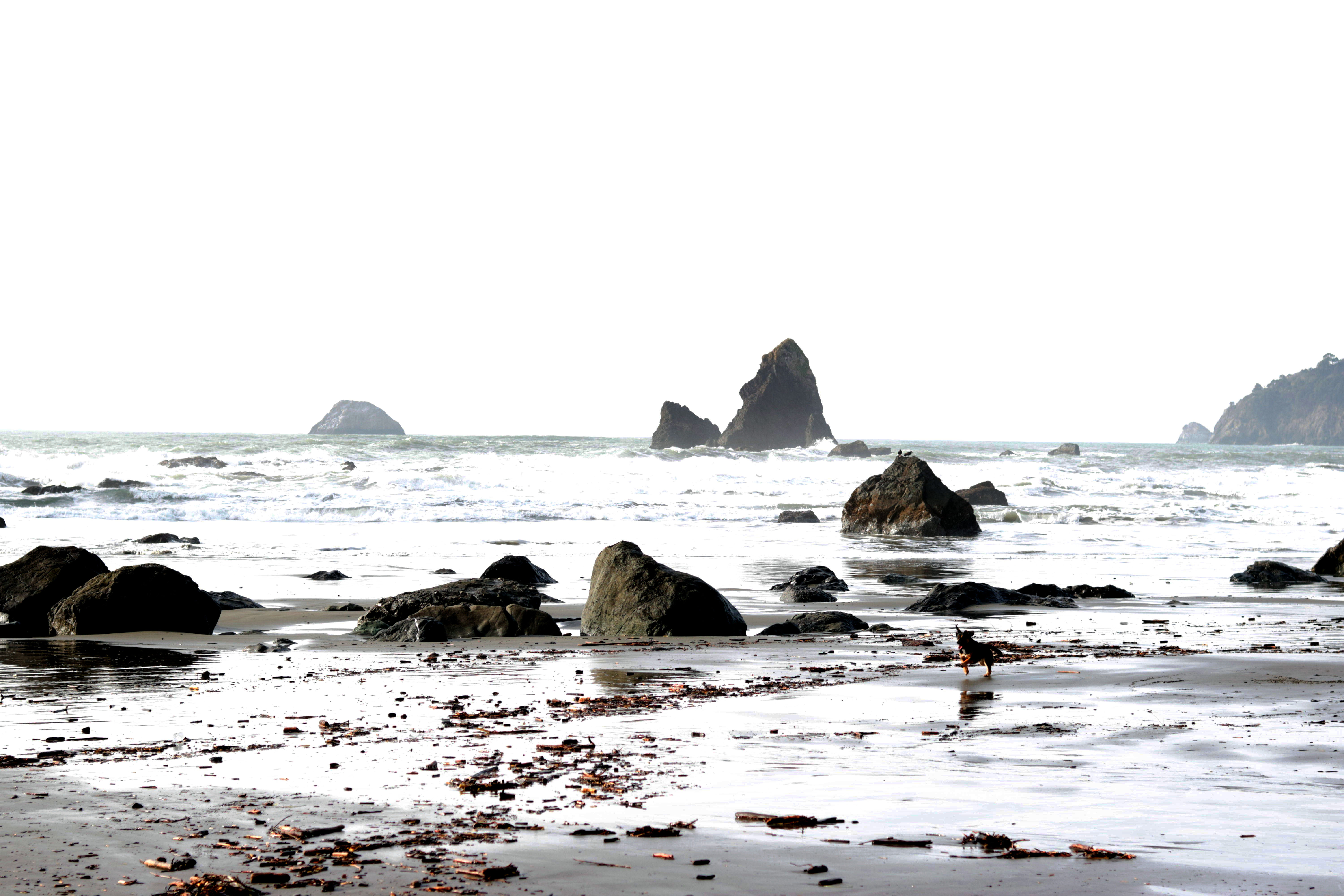
Kelsey: How do they control those designated marine reserves?
Lyf: Oh GPS nowadays. There is something called I think, globalfishingwatch.org, which is a new satellite based system that tracks each fisherman’s boat and what they are doing. It makes sure they are not fishing in marine protected areas and this and that. It’s part of the push against the illegal, unreported and unregulated fisheries (IUU) nationally. Obama started implementing some new systems to regulate that issue. So basically we have an exclusive economic zone that is controlled here off the United States coast line up to 200 miles, but once you get past that 200 miles you enter the high seas and there is no law governing those oceans so that’s the challenge. There is no one responsible for that area and of course there are countries that are trying to ((protect the high seas)), but we are not all the way there. We need more attention on that. And furthermore on that point, that is why it is important not to buy products from China or Indonesia or the Phillipines [or many other places], because you don’t know where they have been caught or where they [were] harvested. And if they were harvested and then brought to those countries and then shipped back to over here we are supporting those IUUs fisheries.
Kelsey: Yeah, and also the fish is being shipped from all over the world which is not necessary and adding to transportation pollution.
Lyf: Well yeah, and that is what is happening here too. Tons of fisheries off the Oregon coast are getting shipped abroad to China, to Japan. The Oregon albacore tuna that I keep talking about, those fish are frozen up on the boats off the coast, taken back to port, put in shipping containers and sent frozen over to China. There they get defrosted, filleted and vacuum packaged in China, boxed back up, frozen and shipped back over here. So it’s twice frozen and shipped back.
Kelsey: Really? That is so inefficient!
Lyf: You would think! But it is still worth while for them, because labor is so cheap over there. And it is totally not sustainable. But you go call up a local seafood supplier and try to get the Oregon albacore tuna loins and they’ll send you a product that says product of China albacore tuna loins and they will say, “Well it’s just been processed in China. It’s still our Oregon albacore tuna loins.” However, now it says product of China, because they have to declare where it was processed and we can’t be sure that they are really sending us back our own albacore. It’s bulls***.
Kelsey: Yeah, there are a lot of issues around out sourcing labor in all sorts of fields, and how that work force is treated amongst other issues.
Lyf: Oh brutal! There are all these reports of slave labor in the shrimp industry and this and that. It’s brutal, yeah it’s dumb.
Kelsey: So if somebody wants to buy sustainable seafood and they aren’t in Portland and can’t buy from Flying Fish Co…. let’s say they go to their local farmer’s market or fish market. What should they be looking for so they can be sure that it is coming from a sustainable source?
Lyf: Yeah, I mean there are two big things, the first being don’t buy anything that is foreign. Don’t buy a product of China, ask where it’s from and double check, triple check. So that’s the start. At least try not to buy anything foreign, now if it is New Zealand or something, okay fine, that’s different than a product of China. So then if it is a product of the United States check the Monterey Bay Seafood Watch or if it is in a bigger box grocery store like Target or Walmart look for the one with the MSC certification. It’s the Marine Stewardship Council, a little blue check mark, and that is a certifying body saying that fishery is being fished in a sustainable manner. So first it is country of origin, second it is Monterey Bay Seafood Watch, third it is MSC certification. I say if we all followed that it would be amazing.
Kelsey: Does the MSC certification have restriction on the way that fish are fished?
Lyf: Oh yeah, it is quite a long process to get MSC certified.
Kelsey: Do you know the standards? Is it all hook and line?
Lyf: Um, not necessarily. There is by catch reduction.
Kelsey: Can you explain what that means?
Lyf: Um, it’s super involved. If you go onto the MSC site they post what the different requirements are for different fisheries, because each one is so unique. Lobster for example is caught differently than let say the Oregon albacore tuna. The MSC certified Oregon albacore tuna is the hook and line caught albacore tuna verses a net. So um yeah, the fishing method is definitely a part of it as well as where it is coming from and stuff. For sure.
Kelsey: Do you think there is ever a situation where it is appropriate to be net catching fish?
Lyf: Oh yeah. Most of the Alaskan fisheries are net caught, gill net caught, and they are still sustainable, because they are highly monitored as to how much fish they are catching, the escapement, to make sure enough fish go up river before harvesting fish… so all those. And our Oregon trawl commission, the fleet who basically net the bottom fish like the dover sole and those sorts of things, they have done awesome work in the last years to become more sustainable. The nets are just up off the bottom of the ocean now so they are not dragging and scooping all the s**t up.
Kelsey: Right, not destroying the ecosystem.
Lyf: All those things need to be worked towards to make it sustainable.
Kelsey: How do they control for bycatch?
Lyfe: Fishermen know the seas pretty well and know they know what areas have the dover sole verses the slope rock fish that are on the endangered species list. So if they catch too many slope rock fish the whole fishery will get shut down for the year, because they can only have “X” amount of those fish caught every year, because they are endangered and there are third party observers on the boat.
Kelsey: In the whole world or just the United States?
Lyf: Just in our fisheries. So yeah there are third party observers, like a government regulator on the fishing boat actually watching them do it. So they can’t just discard those ones over the side and say they never caught them, they are actually getting monitored.
Kelsey: If a fish is caught in a big net and the fishermen don’t want it and they throw it overboard, is it already dead? Is there a chance it will be okay?
Lyf: Ummm… both… Both. No it just depends. They could be alive and they could be dead. Most of them probably dead. So that’s why they have to be really specific about what areas you are fishing in, but once you are out there and you know the depth and you can see the topography you can definitely know where the areas are if you have been doing it for a long time.
Kelsey: Do you think there is a limit to the amount of fish we should eat per week to keep the oceans replenished? You don’t have to give me a very specific number, but if we go “hog wild” on a fish that in considered sustainable seafood we will still run out of it’s supply.
Lyf: So I think there are multiple things. So first of all I’ve done some work and different talks. Chef’s collaborative did a push on trash fish, which is just a slogan for undesirable species. So eating skate wing and sand ((dab)) and sardines and things that aren’t your salmon, cod, tuna, bass… you know your main fish that everyone wants. Well guess what? If everyone wants one kind of fish or five kinds of fish then those five fish are going to get depleted. So eating a bigger variety of species so there is not as much pressure on the single species. And then things like clams and mussels and oysters for example, those are cultured. They are sustainably cultured, farm raised, but they are actually a net positive for the environment because they are filtering, they are bivalves. They are filtering nutrients out of the water as opposed to a fish farm that is putting nutrients into the water. So those you can go hog wild, because they are a net positive for the environment because you are actually taking it out. So there are multiple ways to look at consumption, what it is that you are eating.

Kelsey: As far as farmed fishing goes can you tell me a little about how the difference between a sustainable farm and one that is not?
Lyf: Yeah sure. So Atlantic salmon are a good example of one that is not sustainable. Um, so they are like confined feed lots. Over stuffing these salmon in these pins and feeding, feeding, feeding. So there is not only a bunch of fish s**t coming out the back end, but then there is a bunch of unused feed the fish didn’t even eat that is falling onto the bottom. So then you get algae blooms and parasite issues. Because you have this big body of fish of course parasites are going to flourish in those areas. So then on top of that you have genetically modified grains that their feeds are full of. Another issue is that they are harvesting forage fish from the ocean for the fish feed for the farm fish. So we are harvesting the little fish from the ocean for the nutrients to put in the farm fish feed, and it takes more wild fish to make the farm fish so we are harvesting all these nutrients from the ocean and we aren’t doing it in the right manner. This compared to using a salmon carcass or whatever that we already caught while fishing, using that carcass and grinding it up for the fish feed. Instead we use the new, smaller fish for the fish feed. What is happening right now is we use that carcass, the bones, from the halibut and salmon and stuff to put in the fields for fertilizer, but not using it to feed the farm fish. [And ironically that grain that is fertilized by fish meal is being fed to the fish]. So we are going on collecting more wild, live fish instead of using those fish we already caught for the fish feed for the farm fish. So it’s just backa**wards. Our whole aquaculture for the farm raised fish is really really challenging.
There are a few farms, I sell a few sustainably raised farmed fish. One of them for example is up in Canada called Creative King Salmon and those are certified organic, no artificial color, no hormones, no antibiotics and lower stocking densities. So there are factors, you can sustainably raise fish. They are still using the wild forage fish for the fish meal. So that is one of the categories I don’t agree with, but I still sell that fish. But it is one area that as I continue to talk to more and more people about; it’s trying to bring more awareness to that. So from an industry standard we hopefully start to do something different someday, because that is a total issue.
Kelsey: Isn’t there a way to have a fish farm that’s just nets or something in the ocean that would just keep a diverse ecosystem within it so we don’t necessarily have to make fish feed to put in the farm?
Lyf: Right?! Yeah.
Kelsey: So do people do that?
Lyf: No, not yet. There is actually a trout, there is this place I buy trout from called McFarland Springs Trout and they are a full vegetarian feed. So they don’t get any forage fish from the ocean for the feed and they raise them all the way up, and they are an awesome product.
Kelsey: Is that a natural diet for trout?
Lyf: Not necessarily, but I think [there are] ways we could supplement that. What do they use? I think they use yeast [it’s actually algae]? You can go on their website and check out their information, but I think they use a yeast that is basically the protein. That when they ferment the yeast it creates a protein that they utilize. I mean trout are used to eating bugs. Then you could also farm worms, you could farm maggots, whatever it is you could farm what is not another forage fish from the ocean. So there is a light in the tunnel for sustainable farm raised fish. It’s just there are only a few people doing it and it’s just overall new.
Kelsey; It’s really cool that you are educating people on fishing sustainability and actually trying to change these issues and bring them into awareness in the first place. You can’t fix a problem if you don’t understand it and the consequences of it.
Lyf: Or bring attention that it is just a problem.
Kelsey: Yeah exactly… Well, we need more people like you.
Lyf: Thank you. It’s challenging. Let me tell you, it’s not an easy cup of tea. Any of it. Running your own business, small business, fish, food in particular it’s all really really challenging. Consumers have certain grocery store expectations. Like they want their meat in the case the way it is at big box grocery stores, but like grocery store meat is always defrosted and it’s not actually fresh meat. It’s all this trickery; the regular food industry, they f*****g trick us left and right.
Kelsey: Oh, absolutely!
Lyf: And it’s just me trying to set up these sustainable models. It is really challenging, because people are so set in their ways and they want everything everyday available and guess what? Our farm doesn’t arrive with chickens until tomorrow and I’m not going to defrost frozen chickens so that you can have it today. If you want frozen chicken I have it here, but our fresh one doesn’t come till tomorrow, sorry. People don’t like that.
Kelsey: How do you educate people and teach them that their expectations come from an unsustainable business model?
Lyf: You just do it, and then they f*****g go somewhere else and buy it and hopefully they will come back next time, but it’s just a pain in the a*s. A total pain in the a*s.
Kelsey: It must be hard, because you don’t have time to educate everyone why it is important what you are doing.
Lyf: No, I don’t.
Kelsey: Or why it is important to pay a little extra for the things you are doing and your suppliers are doing. Like certifications, and hook and line wild caught fishing or low density farming, those things take longer and are more expensive for the producer, but if we don’t do it there will be no fish left to fish. I’ve talked to a lot of different businesses like restaurants and produce farmers and they all come into the same issue. They’re like, “This is what a Valencia orange looks like this time of year. It’s green because it is protecting itself from the sun, but it’s still ripe.” However, when you get it from the grocery store they gas it with ethylene to turn it orange. And unfortunately that is what we are used to and people don’t want to buy the green one, because it doesn’t look like what they expect it to be.
Lyf: Right! Exactly, they think it is supposed to be a certain way, but it was all a trickery in the first place! Yeah, all of this is a b***h.
Kelsey: Well I feel like I’m sort of a mediator between the public and the business owner that is trying to make these changes. If people can become educated through these interviews than they can feel empowered to actually understand what is going on since there is so much misinformation.
Lyf: Oh tons! Yeah, education is so key for that.
Kelsey: Just making it accessible and easy for people that don’t feel like they have to time to devote to sifting through the misinformation. So hopefully it will bring more attention to the kind of stuff you are doing.
Lyf: Definitely. Thank you.
Kelsey: I’ll let you get back to work, but it was a pleasure meeting you.
Lyf: I appreciate it.
Kelsey: Thanks for letting me interview you.
Lyf: Of course, thank you, take care, safe travels.
Well that’s it folks! Thank you for reading and if you have any unanswered questions about sustainable seafood comment below! I’ll be sure to get back to you.
